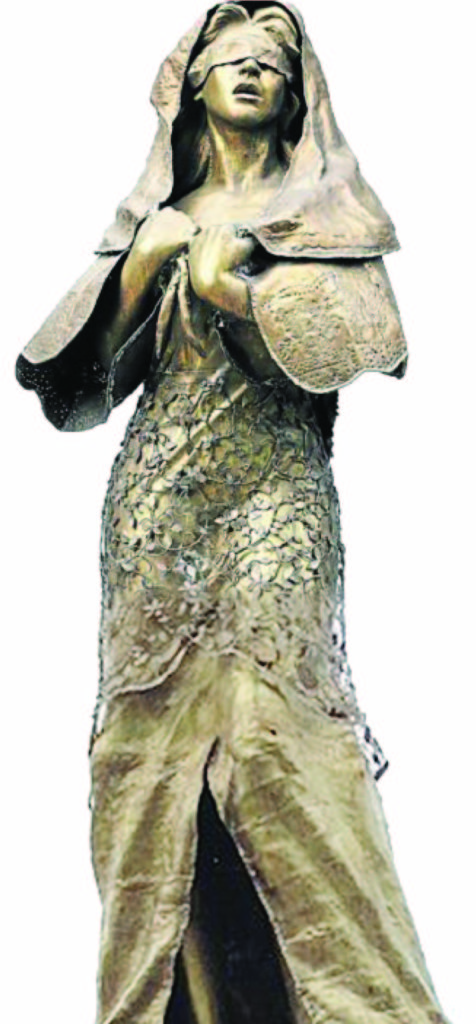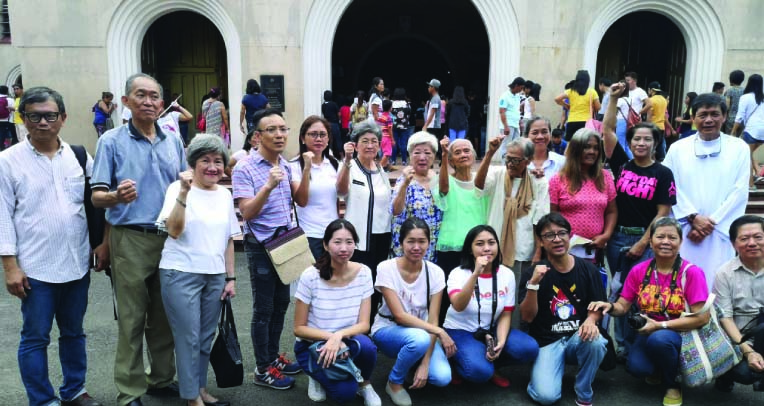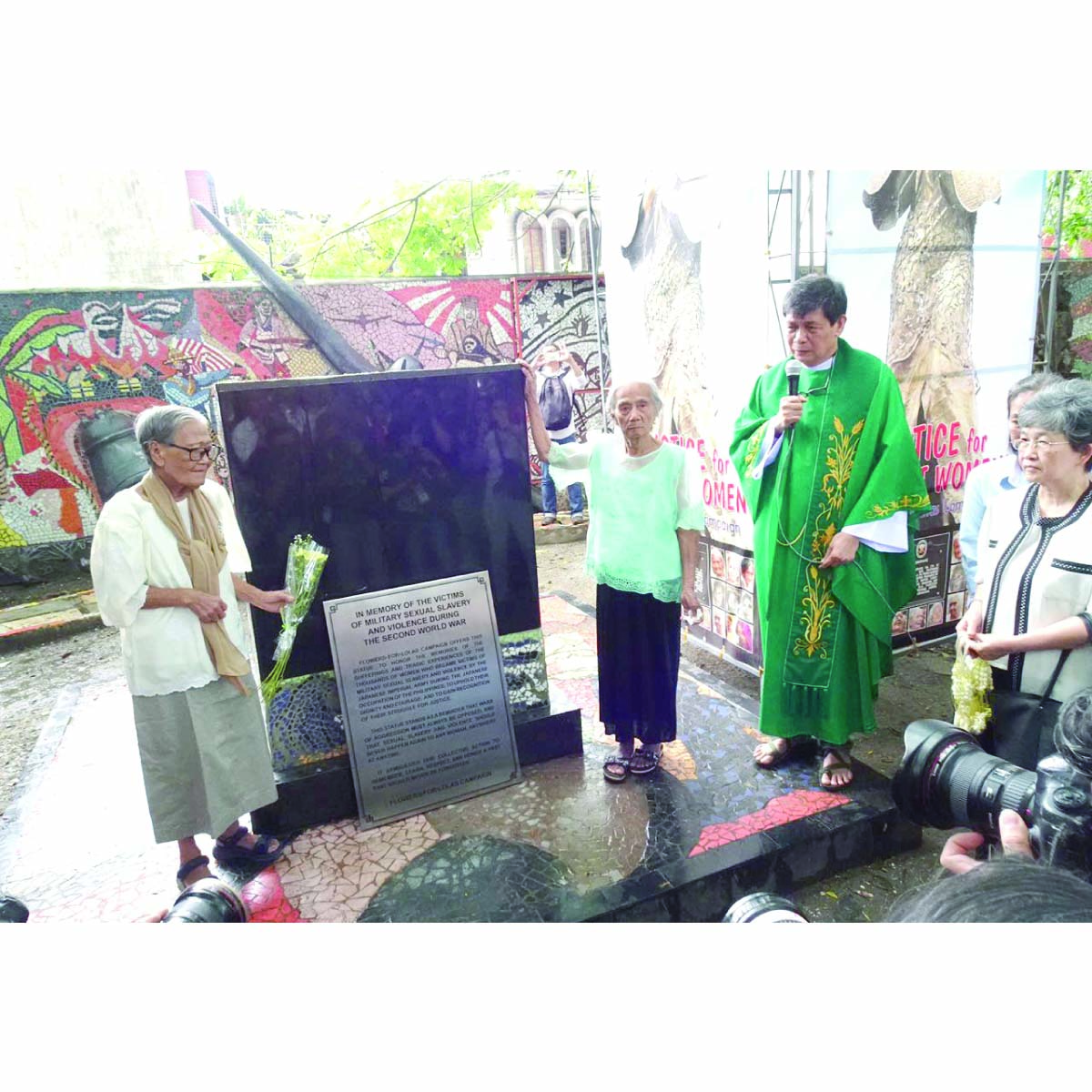
There are “shadows forcing Lolas into silence.”
Lola, the statue representing Filipino comfort women and other victims of sexual violence by Japanese invasion and occupation troops during World War II, has gone missing.
The Lola Filipino Comfort Woman statue was to have been unveiled at its new home, in the garden sanctuary inside the Redemptorist Church in Baclaran, Pasay City. Instead, all that was unveiled last month was a granite pedestal and a marker.
The Lola statue, left in the care of its creator artist Jonas Roces, has disappeared. Roces claimed that it was spirited away by unidentified men from his studio in Cainta, Rizal.
It was uprooted from its first location on Roxas Boulevard along Manila Bay by the government.
Roces was commissioned by Tulay Foundation Inc. to make the two-meter bronze Lola, a statue of a blindfolded woman wearing a traditional Maria Clara gown, her hands clutched at her chest. The statue is worth P1.2 million.
Tulay Foundation is a Tsinoy organization headed by the late Manuel Chua, who was a prisoner-of-war.
Lola is Filipino for grandmother. A reminder of a painful past, the statue honors the memory, courage and resilience of Filipino women who were brutally and repeatedly raped by the Japanese occupying forces.
On Sept. 18, 1992, Lola Rosa Henson bravely decided to come out with her story, and tell everyone what happened to her, with the hope that such an ordeal will never happen again to any woman. She was the first Filipina to tell the world about this heinous and inhuman practice of the Japanese during the war.
The statue represents Filipino women’s dignity and stands as “a reminder that wars of aggression must always be opposed, and that sexual slavery and violence should never happen again to any woman, anywhere at any time,” the marker states.

Four months after its installation in December 2017, the statue was dismantled under cover of darkness on April 27, 2018 by the Department of Public Works and Highways.
It was allegedly to make way for a drainage improvement project but widely seen as submission to protests from Japan: the Japanese embassy had lodged its official regrets over the existence of the statue to Manila’s city hall, the National Historical Commission of the Philippines and the Department of Foreign Affairs.
Issues of historical revisionism and the government’s submission to Japanese policy were raised by concerned groups, led by the Flowers-for-Lolas Campaign, as they condemned the statue’s removal.
President Duterte earlier remarked the state would not want to “antagonize” other countries. He added that the statue could be placed on private property.
In the meantime, what a sacrilege to the memories of war victims that we continue to allow the Japanese to put up shrines to honor their war dead, in Corregidor, in Mabalacat, Pampanga and now in the tunnels in Tarlac, where the Death March started. The survivors and the war dead must be wailing in the continuous desecration and downgrading of their sufferings.
Tulay Foundation commissioned Roces to make the necessary repairs and left the statue with him for safekeeping until a new home could be found for it.
That new home was to be the Redemptorist Church. Roces was present in all the meetings for the planned reinstallation.
But despite several follow-ups on the formal return of the statue to Tulay Foundation for its reinstallation, initially on Aug. 18 then on Aug. 25, Roces failed to respond.
The construction of the pedestal, notwithstanding Roces’ lack of response, proceeded. Wha Chi Descendants Association spokesperson Aquino Lee supervised the construction of the pedestal and environs rushed by a 10-member crew from Arch. Ka Kuen Chua’s firm. A stainless historical marker dedicated to the Lolas at the Baclaran church was provided by Kaisa past president Lyonel Ty.
The Wha Chi is a Tsinoy guerrilla group that fought alongside Filipino counterparts during the resistance against Japanese military occupation of the Philippines during WWII.
Eventually, Roces claimed, through a phone call made to Tulay Foundation, that the Lola statue has been taken away. The call was made two hours after receiving demand letters from Tulay Foundation and Flowers-For-Lolas Campaign.
Civic leader Teresita Ang See, founding president of Kaisa Para Sa Kaunlaran and co-convenor of Flowers-for-Lolas Campaign, said she could hardly believe the sculptor’s claim. There was nothing, no police report, and the artist is nowhere to be found.
Meanwhile, lawyer Virginia Lacsa-Suarez said the statue cannot easily be transferred from one place to another; it took a small crane to remove it from its original location at Roxas Blvd. more than a year ago.
But the absence of the statue did not stop the unveiling on Aug. 25 of the new historical marker.
Broken mosaic tiles adorn the pavement at the base of the Lola statue, symbolizing the broken lives of many lolas, but at the same time made whole and beautiful again because of their courage to share their experiences and tragedies, and the world’s efforts to recognize and honor them and their struggle for justice.

Two of the surviving comfort women, Estelita Dy, 90, and Narcisa Claveria, 91, attended the ceremony. They are living proof that the quest for justice remains alive today.
“Ang giyera, walang pinipili. Ayaw naming maranasan ng bagong kabataan ang dinanas naming kalupitan (War is not picky about its casualties. We don’t want the younger generation to experience suffering and cruelty as we did),” Lola Narcisa Claveria said.
An 8 a.m. mass at the Baclaran church was offered for the elderly men and women. To many, the memories of World War II are dim, made dimmer by the passing on of the lolos and lolas who lived through the horrors of that war.
The Rev. Frs. Victorino Cueto and Teodulfo Holgado of the Redemptorist Church said they welcomed the bronze memorial’s relocation into their piazza but likewise appealed to the people to help find it.
“Nothing happens in a vacuum, the missing Lola is another event that highlights the comfort women issue,” Ang See said.
Earlier, a one-meter tall bronze statue of a girl seated on a chair with fists resting on her lap was removed from the Catholic-run Mary Mother of Mercy shelter for the elderly and the homeless in San Pedro, Laguna, only two days after its unveiling last January.

At present, a life-size statue of two women still stands on the property owned by the family of women’s rights activist Nelia Sancho in Barangay Caticlan, Malay, Aklan that greets Boracay-bound tourists.
“The ‘lolas’ are dying and we didn’t want the issue to die with them,” Sancho said, adding that the issue should be remembered and resolved, not buried and forgotten.
It has been more than 70 years since the war ended on Aug. 15, 1945, and yet, the Japanese government refuses to recognize its official accountability to the victims of sex slavery. Justice has not been given to women such as Rosa Henson. Their fight for an unequivocal public apology, accurate historical inclusion, and just compensation continues.
Help us find the missing Lola statue. — Tulay Fortnightly, September 10-23, 2019 | Vol. 32 No. 7.
